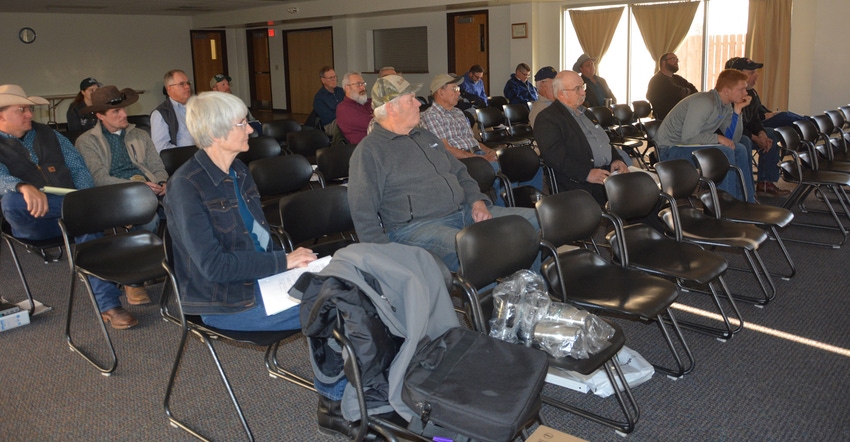
Grazing involves a lot more than just turning cow-calf pairs or stocking steers out on a pasture, and how well cattlemen understand that can have a big impact on the bottom line. That was the message delivered by Travis Mulliniks, a range beef nutritionist with the University of Nebraska-Lincoln, at the Winter Pasture and Forage Conference held in Salina, Kan. on Dec. 12.
Calves are actually taught to graze, Mulliniks said, and they learn from their environment and their dams to select the grasses they prefer. They also have the ability to develop a feed aversion that allows them to choose not to eat plants that have made them sick in the past.
In pastures where toxic grasses are a common problem, cattle accustomed to that pasture will simply ignore the toxic plants.
Mulliniks said that such an aversion can be overcome, however, if those cattle are put into a pasture with other cattle that are not adverse to the toxic grasses.
“If you move cattle from the southeastern U.S. to pastures in New Mexico where they have no knowledge of which forbs are toxic, the naïve cattle will eat the toxic plants and the native cattle who see them eating those plants will also eat them,” he said.
He said the knowledge of how to graze is passed from dam to calf, and that the ability is not instinctual.
“If you move calves into a feedlot and provide them feed in a bunk, they forget how to graze,” he said. “If you then move them from the feedlot back to pasture, you can train them to eat forages that they might not have preferred in the past.”
Cattle will also sample a “novelty feed,” such as molasses feed, because it tastes good and is something new. They will, however, stop eating it after the novelty wears off if they have a choice.
On the flip side, cattle can be taught to eat a forage that they might not select by choice if that is all that is available, and that can be valuable to ranchers who need to rid a pasture of pests such as ragweed, which cattle won’t choose themselves but which actually has good feed value.
“There are palatable plants that cattle naturally prefer,” he said. “If you turn them out in a mixed grass pasture and allow them to select what they want to eat, they will choose the most nutritious and best-tasting grasses. But for ranchers, that will result in patch grazing. You will have some areas that are heavily grazed and others that are left untouched.”
That pattern typically results in the overgrazed areas being susceptible to weed infestations and other problems, he said, which mean that more grazing practices than simply letting cattle choose where to graze are important.
“In the studies, we noted that repeated grazing actually changed the plant communities. We saw that in heavily grazed areas, the plants would change from C3 (warm grass) to C4 (cool grass) populations.”
He said there is also an interesting study of cattle personalities in grazing patterns.
Some cattle, he said, are fast eaters who go right after the forages they want and dig right in, while others are slow eaters who are more watchful, keeping their heads up and watching constantly for predators.
For cattlemen, the takeaway is that the fast eaters tend to also raise heavier calves, cycle earlier and have better overall performance than the slow eaters.
Feeding outside grazing can have a big impact on how cattle graze, Mulliniks said. In pastures in Montana, researchers divided two 1,000-acre pastures. In one pasture, they fed cake three times a week; in the other pasture they left cattle to seek out their own food.
In the pasture where cattle were fed, they tended to walk in circles around the feeding area and watch for the feed truck. In the pasture where cattle were left to seek their own food, they walked in straight lines, grazing more and seeking out preferred forages.
In another study, the cattle were fed every day and they did not even leave the feeding area and search for forage, he said. In the end, the important thing was not whether the cattle were fed, but whether the feed they were given met nutritional needs.
“The ultimate measure of forage quality is feed performance,” Mulliniks said. “It is about feed availability, feed nutrient content, animal intake, extent of digestion and metabolism of feed. What we traditionally know is that gain depends on input.”
Rotational grazing systems can be a valuable tool for ranchers who need to manage pastures to get rid of overgrazed patches or weeds.
“Providing new grass every day increases intake and weight gain. It also decreases selectivity and improves distribution to eliminate those over-grazed patches of preferred grass,” he said.
Rotational or mob grazing can also be useful tools to get rid of undesirable plants, such as ragweed, in the pasture because the bumped up intensity of grazing forces the cattle to eat plants that they otherwise would not choose to eat.
Mulliniks urged cattlemen to be cautious about forced grazing of young heifers nearing breeding season, however. He said that those animals have higher nutritional needs to get them off to a good start with a first calf.
About the Author(s)
You May Also Like




